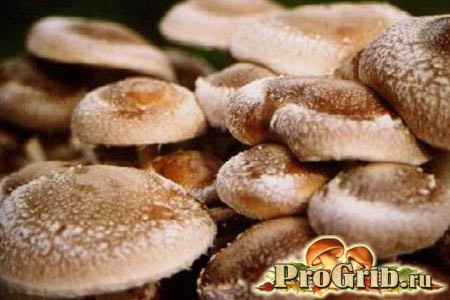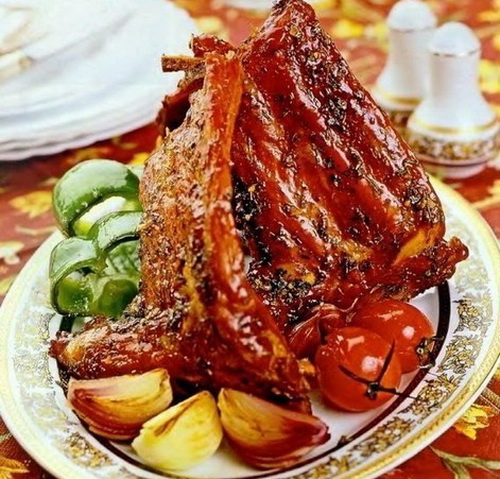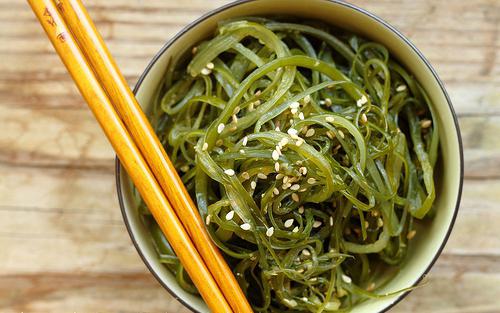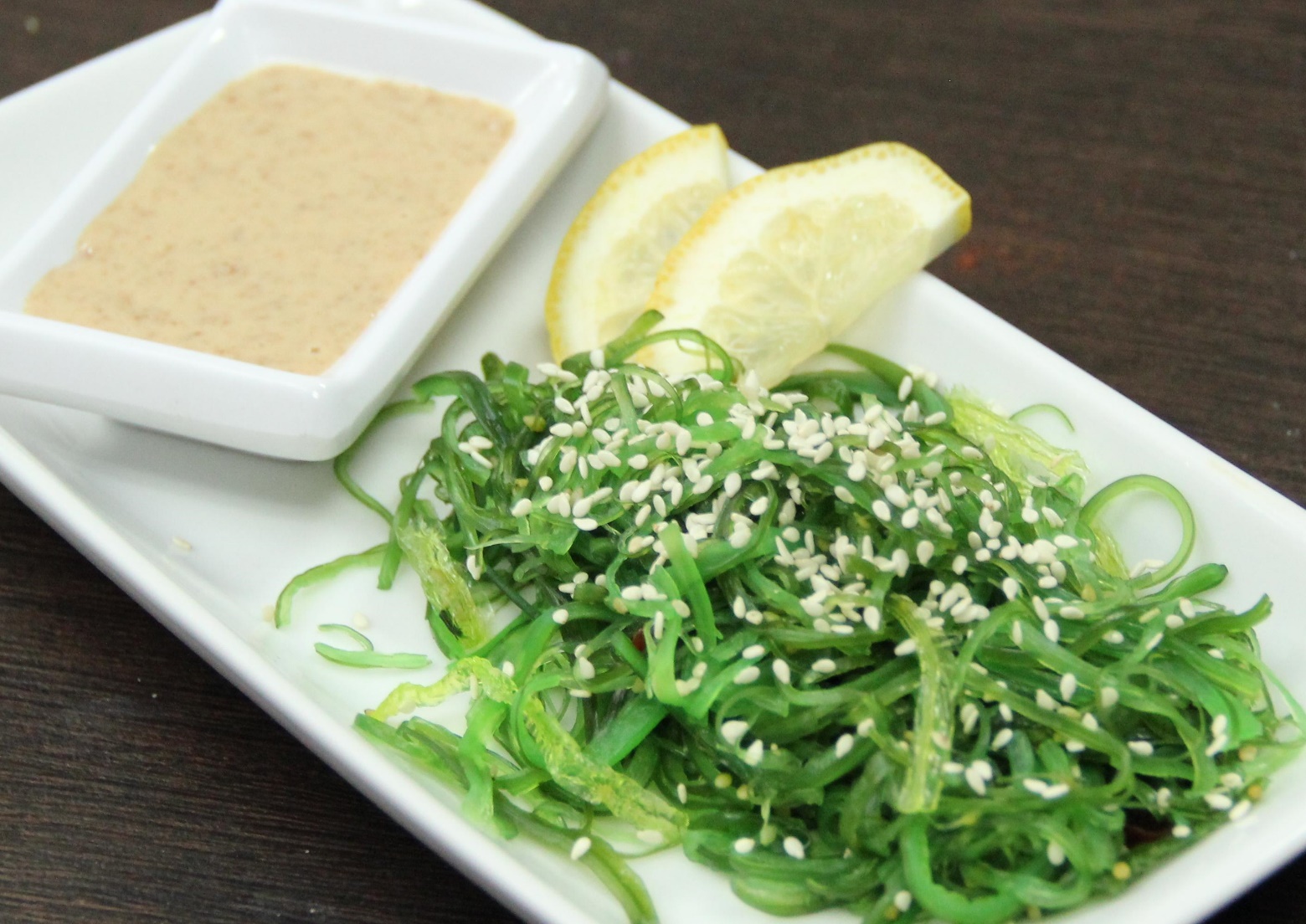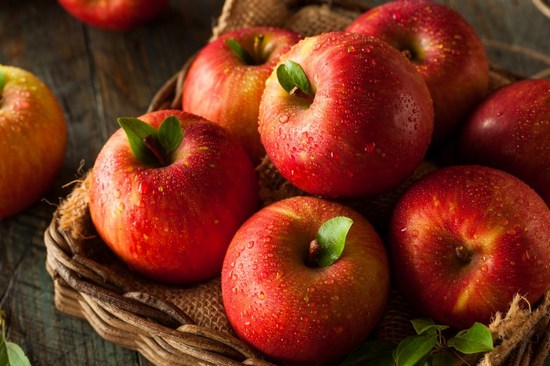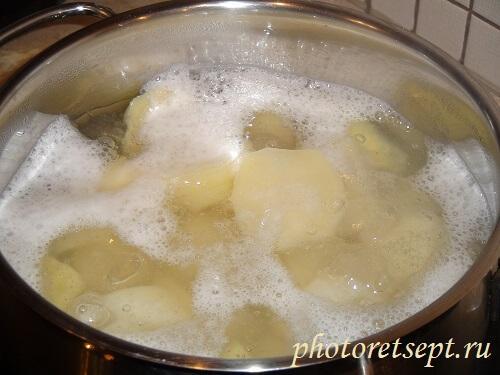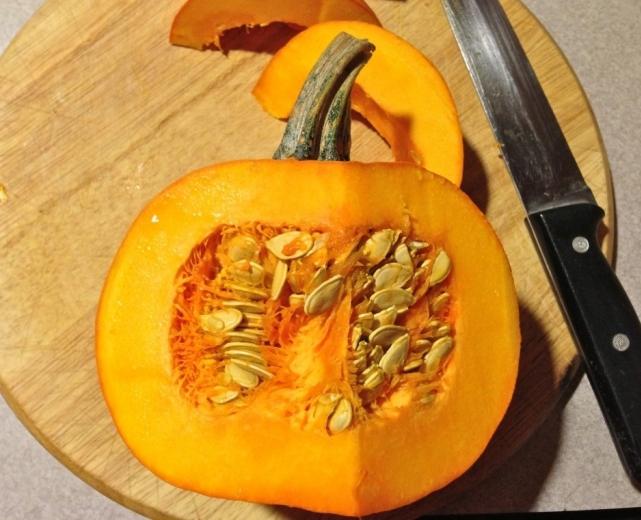Shiitake mushrooms, their benefits and harms. Shiitake mushroom: healing properties
Shiitake mushrooms are the eastern symbol of longevity. The Chinese have used them for medicinal purposes for over 6,000 years. Today, this specific variety of edible mushroom is in second place in terms of artificial cultivation and popularity in the world.
Regarding the benefits of shiitake mushrooms, it is due to its rich chemical composition, including selenium, iron, dietary fiber, protein and vitamin C. Many nutritionists agree that these mushrooms should be added to the diet on a regular basis.
Shiitake mushrooms have a bright forest aroma, slightly reminiscent of the aroma of porcini mushrooms. They are also characterized by a dense fleshy texture.
But these mushrooms are really interesting and popular because of their high nutritional value. A large concentration of vegetable protein (up to 18%), potassium, niacin and other B vitamins, calcium, magnesium, phosphorus.

Among the key beneficial properties of shiitake, the fight against viruses, lowering blood cholesterol, and normalizing blood pressure should be noted.
Lentinan, an immunostimulant obtained from these fungi, is widely used in medical practice to treat cancer, AIDS, diabetes, CFS (chronic fatigue syndrome), fibrocystic mastopathy and other serious illnesses with encouraging results.
Stimulate the immune system
The amazing immunomodulatory properties of shiitake mushrooms are based on complex carbohydrates (polysaccharides) that nourish the immune system and set them on a combat footing.
According to researcher Jeff Chilton, fungal polysaccharides showed excellent results during the experimental treatment of tumors in laboratory animals. The indicated active substances of shiitake act extremely mildly - they strengthen the host's immunity, instead of directly affecting the tumor. For this reason, they are called "immune defense enhancers" (HDP).
Fungal polysaccharides activate macrophages and T-lymphocytes, affect the production of interferon (which inhibits the proliferation of cell protein viruses produced by the body in response to infection) and increase the overall immune response in body cells.
The active components of shiitake mushrooms do not contain poisons, do not have harmful side effects and are clinically safe.
Lower cholesterol
Another substance found in Shiitake mushrooms - erythadenine, studies have shown that significantly reduces blood cholesterol.
The first medical data on this subject appeared in 2001 in the "Experimental Biology and Medicine". The study itself was conducted at the University of Agriculture and Veterinary Medicine (Obihiro, Japan) and proved the effect of the mushroom agent on cholesterol in excrement (upward trend) and in blood (downward trend).
A little later, the scientists Suzuki and Oshima gave accurate results in numbers. It was enough to eat shiitake mushrooms daily for one week, so that the serum cholesterol level fell by 12%.
Fighting cancer
The American Cancer Society recognizes the medical potential of shiitake mushrooms in the treatment of cancer. But since until today all the necessary experiments were carried out exclusively on laboratory animals, more solid evidence is needed.
Oncologists from the USA suggest that the miraculous properties of shiitake mushrooms are due to the content of a polysaccharide called lentinan. It increases the body's resistance to infections and tumors. In addition to the preventive effect, this polysaccharide is able to slow the growth and development of cancer cells in cancer patients.
Strong antioxidant
Natural antioxidants help our body fight off the onslaught of free radicals that can transform body cells and even provoke cancer.
In 2005, the fashionable antioxidant L-ergotionein was found in mushrooms. This was stated by an American research team at a meeting of the American Chemical Society (Washington). It turned out that shiitake mushrooms have the highest concentrations of this powerful antioxidant, significantly more than the other two record-breaking products: chicken liver and wheat germ.
For skin beauty
In January 2003, a report was published in the women's magazine Redbook that some high-end cosmetic companies (such as Chanel) began producing cream for the skin, which included a product of the metabolism of shitake mushrooms, namely kojic acid.
This acid, according to Nora Traiss, a specialist in natural skin care, prevents the production of excess melanin - the skin pigment. Kojic acid has astringent properties, it makes cells shrink, making the skin more elastic.
Selection and storage
Shiitake mushrooms are sold fresh, dried and frozen. When dried, the aroma of the product increases, they are easier to store and easy to restore to their original volume by adding water. Shiitake mushrooms are especially good for soups, stews, sauces and casseroles.
The beneficial properties of shiitake mushrooms largely depend on the method of their cultivation. A high-quality product rich in healing polysaccharides is obtained on natural wood (oak) under natural lighting conditions.
Cheap, but much less valuable mushrooms are grown on sawdust blocks in closed rooms with adjustable humidity. In this case, the nutrient substrate is extremely susceptible to pathogens and competing species of fungi (including poisonous), so manufacturers often use pesticides and fungicides.
Shiitake mushrooms grown in the second way can be eaten only if they are thoroughly cleaned of chemical pollutants. And not all manufacturers give such a guarantee.
That is why picky Japanese are willing to pay no more than $ 8 per 1 kg of mushrooms grown on sawdust, but all $ 80 - for mushrooms grown in natural conditions.
Shiitake mushrooms - benefit and harm.Properties and recipes for cooking shiitake mushrooms
In Japan, China and Korea, dishes without shiitake can be counted on the fingers. Eastern residents simply adore this mushroom, and not only for its taste, but also for its healing properties. There he is called the elixir of youth, beauty, health and longevity. Why is this mushroom so useful?
What is shiitake
Shiitake is known to be an edible agaric that grows on a tree. The hat reaches a diameter of up to 30 centimeters, and its color is light or dark brown. On the edge there is a cream-colored fringe, and the top of the mushroom is covered with scales. If you look under the hat, you can see white fibers in which a mass of useful elements have accumulated. The cylindrical shape of the leg is white, browning with a break, with a fibrous surface.
Shiitake mushroom cultivation
Just the name already speaks of the method of growth. "Shii", translated from Japanese, means a tree of broad-leaved species, and "take" - a mushroom. Other names of this plant are also known: black forest mushroom, Chinese or Japanese mushrooms, and its Latin name is edible lentil. In vivo, shiitake grows in the east: Japan, Korea, China and some parts of Southeast Asia.
Such mushrooms are cultivated in Russia: in the Far East and in the Primorsky Territory. There are only two types of artificial production:
- outdoors - an extensive way of growing;
- in the greenhouse - an intensive way.
The cultivation of shiitake mushrooms with an extensive method takes from 6 to 12 months. To begin with, small depressions are made on pieces of wood into which the shiitake mycelium or its whole culture is laid. Then the logs are kept in the shade for a while, at a certain temperature and humidity. The fruiting of mushrooms on logs lasts from 3 to 5 years, and the yield from 1 cubic meter. m of wood is about 250 kg.
An intensive method involves the cultivation of shiitake on a mixture of hardwood sawdust with wheat or rice bran, in special propylene containers. Initially, the substrate is sterilized, pasteurized in hot water, dried and only after that the mycelium is planted in the soil. On one block, the mushrooms will grow from 30 to 60 days, and the yield for the entire fruiting period will be 15-20%.
Shiitake - benefits and harms
Shiitake dishes are not only low-calorie (nutritional value of 1 kg - 300-500 kcal), but also useful. For example, there is as much calcium as fish meat. In addition, they contain a lot of phosphorus, iodine, potassium, zinc, complex carbohydrates and B vitamins. The accumulation of substances is concentrated on the hat, because only spores are formed there. At the stalk, micro and macro elements are 2 times less. Therefore, dietitians are advised to trim the bottom, and cook as many hats as possible.
It is worth knowing that the benefits and harms of shiitake are a very controversial topic. As it turned out, even they are imperfect. Sparingly soluble mushroom protein is practically not absorbed by our body. In addition, chitin fiber contributes to poor digestion. It interferes with the production of gastric juice and passes through the body in transit. For these reasons, doctors do not recommend giving shiitake to children under 3 years of age, and adults can consume no more than 300 g of mushrooms per day.
Shiitake mushroom - healing properties
The Japanese Shiitake are called the elixir of longevity - dishes from it were often served at the imperial table. And in Russia, the benefit of an overseas guest was recognized several decades ago. There is even a whole science - fungotherapy, which studies the healing qualities of mushrooms. It is proved that the healing properties of shiitake lie in a rich vitamin composition:
- Polysaccharides, leucine, lysine normalize the gastrointestinal tract, contribute to weight loss.
- Ergosterol was found in dried mushrooms, which, when absorbed, turns into vitamin D.
- Amino acids lower the level of sugar, bad cholesterol, and improve blood circulation. This makes the fungus an indispensable product for diabetes and hypertension.
- According to Chinese studies, the presence of this fungus in the diet will increase resistance to stress, help to cope with exhaustion and weakness.
- Lingans with lingins - virus-like particles that are part of shiitake, help the body resist the herpes and hepatitis viruses.
- With complex therapy, shiitake is used to treat the upper respiratory tract, flu, smallpox, polio and even HIV.
- Eating 16 grams of dried mushrooms per day will increase immunity, prevent the development of heart diseases: atherosclerosis, coronary heart disease.
- Chitin with cellulose helps cleanse the blood of chemical, toxic, radioactive substances.
There is unconfirmed evidence that the fungus helps well in the treatment of stomach ulcers, gout, hemorrhoids, liver pathologies, prostatitis, and sexual impotence. Some companies specializing in medical cosmetics for women produce anti-aging products based on Japanese mushrooms: creams, cosmetic masks, lotions. Lentinan, added to the composition of this cosmetics, stops premature skin aging.
Shiitake tincture
If you want to have beautiful velvety skin, as in the photo of Japanese geishas, \u200b\u200bit is not at all necessary to buy expensive creams. The shiitake tincture prepared at home will cope with the tasks set. Skin lotion is made according to a simple recipe:
- Dried mushrooms are mixed with alcohol in proportions of 2 to 1.
- Close the container with a lid, and then insist 7-10 days.
- The finished solution is applied to a cotton pad and rubbed on the face, except for the eye area and nasolabial folds.
- The procedure is repeated regularly: in the morning and in the evening.
Shiitake mushroom in oncology
Extracts and extracts from shiitake have been used in the prevention and rehabilitation of cancer patients. Science has found that these medicinal mushrooms have strong antitumor properties, but this does not mean that it is worth stopping the main treatment and refusing operations. Shiitake mushroom in oncology only reduces the spread of cancer cells, slightly reduces the size of the tumor, enhances the effects of chemotherapeutic procedures, restores the blood formula, relieves pain.
Shiitake mushrooms - how to cook
The Chinese mushroom is used not only by doctors, they are often included in the composition of dishes. Making shiitake is not a complicated process. On the palate, they resemble a cross between a porcini mushroom and champignons. Fresh they can be used in salads or snacks recipes. This mushroom will emphasize, embellish and enrich the taste of any unsweetened sauce. In Chinese, Japanese and Korean cuisine, shiitake is used to make rich miso soups.
How to cook frozen shiitake mushrooms
Before you start cooking frozen shiitake mushrooms, you must let them stand at room temperature for 2-4 hours, and then squeeze out excess moisture. The easiest option is to fry the mushrooms in a pan with vegetable oil. You can add onion, lemon, sesame seed to the product. Often, frozen shiitake is added to more complex dishes of meat, fish, vegetables, and seafood.
How to Cook Dried Shiitake
Dry mushrooms before cooking need to be soaked in warm water with the addition of a teaspoon of sugar. If after this you plan to cook the dried shiitake further, rather than spreading it in the salad as it is, then you can prepare the marinade for steaming. To do this, mix sesame oil, soy sauce, garlic, spices and lemon juice. Marinate with a mixture of mushrooms at night, and in the morning continue cooking according to the recipe.
Shiitake mushroom in recent years has become a habitual inhabitant of store shelves in the post-Soviet space, meanwhile, in China it has been known for 2 thousand years, and also grows in Japan. In these eastern countries, it grows not only in the natural environment, but also cultivated with great success. In Chinese medicine, it is considered a very healing product that can significantly increase life expectancy with regular use.
Shiitake mushroom in recent years has become a familiar inhabitant of store shelves in the former Soviet Union
To date, this mushroom is used not only in cooking, but also as a therapeutic agent. In order to grow it in an artificial environment, there are several methods.
If shiitake is grown using pressed sawdust, which is mixed with mycelium, then although they will have the necessary taste, they will contain useful active substances to a minimum. A product grown in this way is sold at grocery stores. In order for shiitake and healing properties to have, they must be grown in natural conditions or cultivated on wooden decks. In the eastern region, extracts of naturally grown mushrooms of this species are used to create biologically active preparations and various useful food additives.

What is the benefit
After the work on the study of the composition, scientists found that this type of mushroom contains B, C, D vitamins, retinol, trace elements, a large number of essential amino acids (those substances that can be obtained only from the external environment, the body does not produce them on its own), fatty acids. In addition, Q10 was found in the composition - a coenzyme, which is a powerful antioxidant, acts on redox processes in the cells of the whole body.
Polysaccharides, which are also found in this type of mushroom, are able to have a positive effect on the formation of interferon, thereby significantly improving the functioning of the immune system and resistance to various pathogens of infection. The properties of the product in stimulating the immune system make it possible to compare it with another plant common in the East - ginseng.
 In Chinese medicine, this mushroom is considered a very healing product.
In Chinese medicine, this mushroom is considered a very healing product. In addition, these mushrooms contain substances that prevent the formation of blood clots and help to significantly lower cholesterol: with regular use, its blood level decreases by 10%.
The use of Shiitaka helps to reduce the risk of strokes, heart attacks, hypertension.
In eastern medicine, these mushrooms are used to treat diabetes, as well as the complications associated with it, to detoxify the body and strengthen the nervous system. Supplements containing mushroom extract are prescribed as one of the components in the complex treatment of respiratory, oncological, dermatological, and nervous diseases.
 In eastern medicine, these mushrooms are used to treat diabetes and the complications associated with it.
In eastern medicine, these mushrooms are used to treat diabetes and the complications associated with it. The use of shiitake helps to normalize the metabolism, favorably affects the functioning of the digestive tract, stimulates the breakdown of fats (for this reason, those who want to lose weight often add them to their diet).
Gallery: Shiitake mushrooms (25 photos)







King of healing mushrooms (video)
Against oncology
Years of hard research have revealed that the lentinan polysaccharide contained in shiitake is needed by the human body in order to produce special substances that can resist cancer cells, as well as volatile, they will fight against influenza, hepatitis and HIV viruses.

In such eastern countries as Singapore, Korea, Vietnam, Japan, China, the methodology for the fight against cancer, including the use of shiitake (PROGMA), is even recognized as official medicine. Doctors may prescribe it in combination with traditional oncology treatments. PROGMA is prescribed in case of both malignant and benign neoplasms at any stages. A similar treatment is also used to restore the body weakened by radiation or chemical therapy.
The treatment of various diseases with the help of mushrooms (fungotherapy) involves the use of their extracts, since in this form the concentration of healing substances is significantly higher compared to alcohol tinctures, which are prepared on the basis of mushroom powder, or other means. Shiitake is often used in capsules that contain the necessary dosage of dry extract with the addition of B vitamins and tocopherol.
This dietary supplement still has some contraindications: pregnancy, lactation, age up to 12 years.
Despite the great benefits of the product, the use of shiitake requires caution due to the high content of chitin. This substance is unable to be digested when it enters the stomach, for this reason it should not be abused. In addition, individual intolerance to the drug may occur, exacerbation of bronchial asthma due to allergens contained in the composition. Therefore, before using this product, you must consult a specialist to exclude the possibility of negative consequences.
 Despite the great benefits, the use of these mushrooms requires caution due to the high content of chitin
Despite the great benefits, the use of these mushrooms requires caution due to the high content of chitin In addition to its use in medicine, this mushroom has become widely used in cosmetology. Those cosmetics that contain shiitake extract in their composition have a beneficial effect on the skin:
- it becomes smoother, firmer;
- wrinkle depth is markedly reduced;
- sebum secretion is normalized;
- cell regeneration improves;
- enlarged pores are reduced.
In order for these mushrooms to bring the body only benefits, it is necessary to choose them correctly: they should not be under-dried or covered with mold. It is best to purchase a ready-made proven drug in capsules in a pharmacy (supplements), but take it only after prior consultation with your doctor.
Shiitake mushrooms (video)
Recently, this mushroom is gaining popularity in our country. It is increasingly discussed, around the shiitake there is heated debate about its beneficial properties. It literally became a sensation in the treatment and maintenance of a healthy lifestyle. You can meet shiitake on dead trees, it can be chestnut, oak or maple. It is used for cooking dishes with a special and mysterious zest. The mushroom is fully suitable for consumption. In the east, shiitake is often compared to the famous ginseng. In this article, we will tell you about shiitake and its benefits and harms.
Shiitake History
There is still no reliable information about the homeland of Shiitake. It can be called China and Japan at the same time. Europe and Russia have only recently begun to use the mushroom and show demand for it. In eastern medicine, the mushroom was used several centuries ago and in modern conditions it does not lose its relevance. It is called the elixir of a healthy life and the medicine of emperors.
The benefits of shiitake
In addition to the widespread use of shiitake, it is used as a healing agent and a cure for many diseases. What is the reason for this ?! Everything is very simple, all thanks to the rich chemical composition of the product. Shiitake is rich in essential amino acids, fatty acids and polysaccharides. The mushroom also contains zinc, selenium, iron and manganese.
Shiitake for tumors
 Recent studies have found that shiitake contains substances that inhibit the development of malignant tumors. The chemical composition also includes volatile, which have anti-inflammatory properties. They block bacteria that cause the common cold and even serious hepatitis viruses. The destruction of cancer cells occurs due to lentinate, this is a unique component. He forced medicine to take a fresh look at cancer treatment methods. Not every product boasts this property. And for mushrooms, this is really a sensation.
Recent studies have found that shiitake contains substances that inhibit the development of malignant tumors. The chemical composition also includes volatile, which have anti-inflammatory properties. They block bacteria that cause the common cold and even serious hepatitis viruses. The destruction of cancer cells occurs due to lentinate, this is a unique component. He forced medicine to take a fresh look at cancer treatment methods. Not every product boasts this property. And for mushrooms, this is really a sensation.
How to grow Shiitake
When it became known about the healing properties of shiitake, industrial cultivation began. Before aggravation of demand, wooden substrates were used for mushroom cultivation, but over time the process was simplified and sawdust began to be used. This method destroys half of the healing properties of shiitake. The classical method is still relevant, but they resort to it when you need to get the most benefit from the product.
The benefits of shiitake for the heart
Mushrooms are used as a remedy against arterial hypertension. Shiitake brings the condition of blood vessels back to normal, it makes them resilient and elastic. There is also a decrease in blood cholesterol, which is the most important factor for the treatment of cardiovascular diseases. Shiitake can serve as a restorative and firming agent after heart attacks and strokes. The fungus normalizes the heartbeat. It can reduce the frequent heart rate or vice versa increase the frequency of beats per minute.
Shiitake and prevention and treatment of diabetes
Shiitake lowers blood sugar. He acts as a controller. Using mushrooms, drugs are made to treat diabetes. Scientific experiments have shown that regular intake of shiitake or the medications it is part of supports the optimal glucose level.
The benefits of shiitake for the upper respiratory tract
Frequent colds cause the bronchi and lungs to take on the blow from bacteria and viruses. Shiitake has an antimicrobial agent. It will help get rid of cough and improve sputum discharge. Shiitake acts versatile, filling the body with energy to fight the disease. It destroys the harmful effects of bacteria and has a fixing effect in the form of stimulation of the immune system.
Calorie content and diet.
Japanese nutritionists have made a real discovery by developing a diet involving shiitake. This is more like a complete nutrition system than a diet. Participants who tried the effect on themselves noticed an improvement in their body condition. The mushroom has a low calorie content, which does not exceed 40 Kcal per 100 grams of product. The Japanese claim that shiitake still has many unexplored properties that can help in the fight against various ailments, although it would seem that the mushroom already has a very wide range of effects.
The benefits of shiitake for the nervous system
Among other advantages, shiitake improves brain activity and activates memory. It is useful to use with increased mental stress. Elderly people often suffer from sclerosis, this is due to cessation of nutrition. Vitamins and trace elements responsible for brain activity no longer enter the brain. Shiitake fights this disease, improving the absorption of essential substances. Over time, the perception of information and its storage in a person’s memory improves. This function will also benefit young people, especially children. At an early age it is very difficult for them to remember information. Shiitake will cope with the challenge.
Shiitake removes salt from the body
Shiitake is effective for gout. Mushrooms remove salt from the body. It is known that gout cannot be completely eliminated, but this disease can be turned into a long remission. Regular consumption of mushrooms will help to remove salt before it crystallizes and will bring hellish pain in the limbs. Of course, in addition to shiitake, it is necessary to maintain an appropriate diet prescribed by the attending physician.
The benefits of shiitake for male and female health
Oriental medicine has come to the conclusion that shiitake has a positive effect on male and female health. Menopause in women is accompanied by unpleasant symptoms in the form of sweating, hot flashes and itching in the genital area. Many say that these are unavoidable symptoms that will have to be endured. But Japanese doctors have proven the effectiveness of fungi in combating the symptoms of menopause. The condition improves and returns to normal with constant use of drugs based on shiitake. In addition, the fungus activates potency and helps to increase male strength, this is due to  unique components contained in the composition.
unique components contained in the composition.
The benefits of shiitake for the stomach
It is believed that fungi cause fermentation processes in the intestines and are difficult to digest. This statement cannot be attributed to shiitake. These mushrooms help improve digestion, they strengthen the walls of the stomach. The intestinal microflora comes to normal. It is worth noting that this effect does not apply to people suffering from chronic diseases of the gastrointestinal tract.
Shiitake in cosmetology
Shiitake also found his place in cosmetology. It is used for the manufacture of fortified creams, masks. It contains amino acids that improve cell regeneration. This slows down the aging process of the skin and moisture loss.
Harm Shiitake
Shiitake, like any product, has contraindications. It is not recommended for pregnant women to use while breastfeeding. Allergic reactions or individual intolerance may also occur. You can’t eat mushrooms in large quantities, it’s better to choose moderate consumption. It is necessary to introduce the product gradually to detect the presence of allergies or side effects in the early stages. But all these aspects cannot be called harmful properties of shiitake. Rather, they relate to the individual reaction that occurs in any person individually.
Shiitake - mushrooms with medicinal properties that are widely used in the treatment of malignant tumors. But the healing properties of shiitake do not end there.
| The nutritional value |
|---|
|
A portion 100 g |
| Quantity Per Serving |
|
Calories from Fat 4,41 |
|
% Daily Value * |
|
Total fat 0.49 g |
|
Cholesterol |
|
Sodium 9 mg |
|
Potassium 304 mg |
|
Total carbohydrates 6.79 g |
|
Sugar 2.38 g |
|
Alimentary fiber 2.5 g |
|
Squirrels 2.24 g |
|
Vitamin B6 |
|
Vitamin D |
|
* Calculation for a daily diet of 2000 kcal |
The ratio of BJU in the product
Source: depositphotos.com
How to burn 34 kcal?
Description
Shiitake is a popular delicate mushroom that is grown mainly on long-pointed castanopsis trees.
The homeland of the fungus is the countries of Southeast Asia and China. It has been grown on specially treated wood stumps in the mountainous regions of Korea, China, Japan since very ancient times. The first written review of Shiitaka regarding its use in food dates back to 199 BC, and in Chinese medicine it has been used since more ancient times. According to some sources, this mushroom was used by Chinese emperors to protect themselves from various diseases and prolong youth.
In the 70s of the last century, shiitake began to grow in America and Europe, where he began to enjoy great popularity. The mushroom has a pleasant aroma and taste, soft texture, which allowed it to occupy the forefront among cultivated mushrooms. Today, along with traditional technologies, shiitake mushrooms have also been successfully grown on sawdust enriched with special nutritional supplements.
The mushroom hat has a dark brown color, which in diameter can reach 5-20 cm. A beautiful pattern of cracks and thickenings can be observed on it. The leg is fibrous, in young mushrooms with a protective plate that breaks when the spores mature. The most useful mushrooms are those in which the hat is open at 70%, in diameter does not exceed five centimeters, with a dark brown velvety color.
Judging by the many positive reviews, Shiitake is very popular and is widely used in cooking. In addition, shiitake treatment is also a success. In Japan, the mushroom is very much appreciated for the fact that it absorbs the taste of other ingredients, but does not suppress them. And in Europe, shiitake is an indispensable ingredient in various dishes due to the characteristic caramel smell and ease of preparation.
A lot of soups, seasonings and even drinks are prepared from the mushroom. It is added to hot dishes, as it goes well with meat, vegetables and noodles. Cooking shiitake on the grill and baking in tempura is popular (for this it is better to use mushrooms with large hats in diameter).
The composition and calorie content of shiitake
100 g of Shiitake mushrooms contain 89.74 g of water, 4.29 g of carbohydrates, 2.5 g of fiber, 2.24 g of protein, 0.73 g of ash, 0.49 g of fat; vitamins: retinol (A), thiamine (B1), riboflavin (B2), niacin (PP), pantothenic acid (B5), pyridoxine (B6), folic acid (B9), cyanocobalamin (B12), calciferol (D); macronutrients: phosphorus, sodium, magnesium, calcium, potassium; trace elements: selenium, zinc, copper, manganese, iron.
The calorie content of shiitake is 34 kcal per 100 g of product.
The beneficial properties of shiitake
The healing properties of shiitake are widely known in Japan. For many centuries it has been used primarily for the prevention of heart disease, colds, tumors, and hypertension. Shiitake treatment is believed to prevent sexual disorders and problems caused by aging. Reviews of the Shiitake of the inhabitants of Japan indicate that they consider it an elixir of life, which refreshes both the mind and body.
Shiitake is not so popular in our latitudes, although, thanks to a wide range of preventive and therapeutic effects, this exotic mushroom is eaten all over the world. Two decades ago, shiitake was considered a very expensive and very rare oriental delicacy. Currently, in the West, the mushroom is becoming more widespread, so it can already be easily found on the shelves of supermarkets. Increasingly, the treatment of shiitake began to be used for such common diseases of the 20th century as AIDS, cancer and cardiovascular diseases.
Shiitake mushroom is an ideal protein due to the fact that it contains ten amino acids that are indispensable for the human body, and in such a proportion that is most suitable for human nutrition. Along with many enzymes and vitamins, the fungus contains such amino acids as lysine and leucine, which leads to very important healing properties of shiitake, as these amino acids are practically absent in cereals. In addition, the mushroom is an excellent source of B vitamins, including vitamin B12.
In addition to the prevention of the above diseases, reviews of shiitake indicate that it is effective in high blood pressure, slows down the aging process and lowers blood cholesterol. The world-famous mushroom researcher, Marie Kisako, claims that shiitake treatment is useful for kidney stones, diabetes, stomach ulcers, anemia, vitamin deficiency, and colds. From his scientific works, one can learn that the fungus has a pronounced antibacterial and antiviral effect, since the polysaccharides contained in it prevent viruses and bacteria from multiplying.
Thanks to the lentinan contained in the fungus, the anti-tumor property of shiitake is proved. At the Tokyo State Oncology Research Institute, studies conducted in the 60s of the last century scientifically confirmed the anticancer effect of the fungus. Test results were published in the American oncological journal Cancer Research. Thanks to these data, Japanese scientists have achieved impressive results in the treatment of patients in a relapse or advanced stage of the disease.

Today, in many cases, in the treatment of cancerous tumors, along with chemotherapy, patients are prescribed shiitake mushroom extract in order to reduce the toxic effects of drugs on the immune system and healthy tissues.
According to recent studies, it is proved that in a tissue culture environment, shiitake inhibits the multiplication of the HIV virus, which causes AIDS. Scientists at the same Tokyo State Cancer Research Institute have come to believe that shiitake mushroom extract prevents cell destruction caused by the HIV virus. Thus, the shiitake mushroom is of interest to scientists involved in the treatment of AIDS.
Contraindications
Shiitake mushroom is the only fungus that can cause allergic reactions in the body. Therefore, it is necessary to introduce it into the diet from small portions, gradually increasing them.
In addition, pregnant and lactating women are not recommended to consume a mushroom, as it contains too many biologically active substances.
Video from YouTube on the topic of the article:

